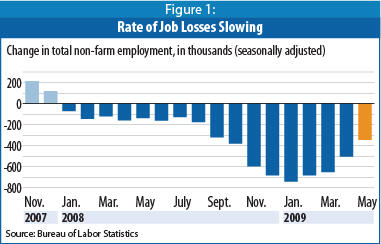Statement: Chad Stone, Chief Economist, on the May Employment Report
Today’s jobs report shows a labor market that is still deteriorating but that offers signs that the worst of the current recession may be over.
Job losses in May, while still high at 345,000, were less than half of January’s level. The unemployment rate jumped to 9.4 percent but, for the second month in a row, the labor force grew as more people entered it to look for work than left it.

Unfortunately, the labor force growth was more than offset by an increase in the number of people who lost their jobs or ended temporary jobs. As a result, the number of unemployed workers continued to rise. For the labor market to really rebound, employers have to see clear signs that a sustainable economic recovery is underway — and we are not there yet.
About the Jobs Report
The recession that began in December 2007 is the longest in the post-World War II era and has now entered its 18th month. Job seekers continue to face a very difficult labor market.
- Private and government payrolls combined have shrunk for 17 straight months, and net job losses since the start of the recession total 6.0 million. (Private sector payrolls have shrunk by 6.3 million jobs over the same period.)
- Nonfarm payrolls fell another 345,000 in May. Most of that came from the private sector, where employers shed 338,000 jobs.
- The official unemployment rate, which was 4.9 percent at the start of the recession in December 2007, reached 9.4 percent last month, its highest level since August 1983.
- The percentage of the population with a job (59.7 percent) has not been this low since October 1984.
- The Labor Department’s most comprehensive alternative unemployment rate measure — which includes people who want to work but are discouraged from looking and people working part time because they can’t find full-time jobs — stood at 16.4 percent in May, up 7.7 percentage points since the recession began and the highest level on record in data that go back to 1994.
- Well over a quarter (27.0 percent) of the 14.5 million unemployed have not been able to find a job despite looking for 27 weeks or more. The economic recovery legislation enacted earlier this year provides additional weeks of unemployment insurance (UI) benefits to those workers who exhaust their 26 weeks of regular UI benefits, but the job market is so weak that many workers are likely to exhaust those benefits as well before finding a job. In addition, the temporary benefits program is scheduled to expire at the end of this year and will need to be renewed.
The Center on Budget and Policy Priorities is a nonprofit, nonpartisan research organization and policy institute that conducts research and analysis on a range of government policies and programs. It is supported primarily by foundation grants.
